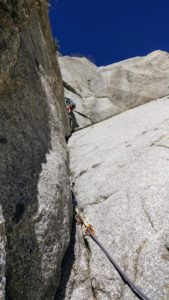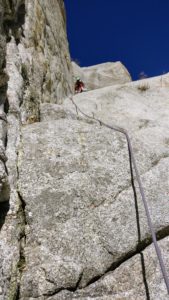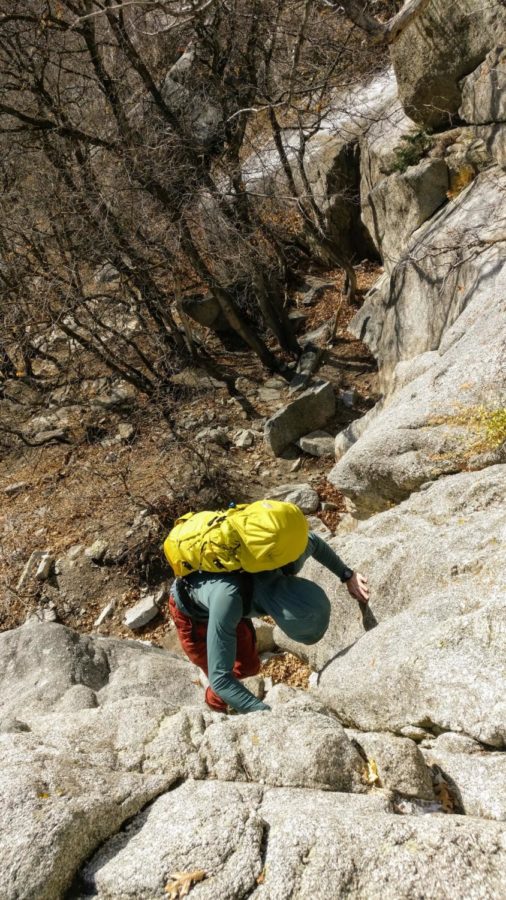Intro to Trad Climbing
Trad climbing can be a bit of a daunting sport to get into initially. Leading any climb can be spooky mentally, but at least with sport climbing, you have the mental security of bolts as your protection. Even though trad gear when placed correctly is very reliable, placing your own protection can be a hard concept to wrap your head around. However, there are baby steps that you can take to make the learning process easier. It’s important to be aware that trad climbing is more than just learning new technical skills. There is also a learning curve for fear management that plays just as big of a part in the process.
Before you start trad climbing, you need to know how to place gear. Generally, there are two different types of gear you can place: cams and nuts. These pieces come in a variety of sizes that will fit into a variety of features on rock. There are many companies that sell this gear with some differences across them, but for our introductory purposes, these are not important.
Generally, when placing a cam, you want to look for a relatively parallel crack. You want to maximize the surface area between the cam and the rock so that all four lobes of the cam are in contact with the rock. There are two general mistakes beginners make when placing cams. First, some will undercam the piece. This means the cam has an umbrella shape to it when placed or that it is barely retracted. This increases the chances of the placement popping because you are leaving the cam with very little range to expand in the event of a fall. The second mistake is overcorrecting and overcamming your piece. This is when you almost fully retract the cam. While this is quite a safe placement in the event of a fall, it is also an easy way to get a piece stuck. When you overcam a piece to the point where the trigger no longer moves the piece, it can be difficult if not impossible to remove the cam. Trad gear is quite expensive, so you want to avoid getting a piece stuck whenever possible. The ideal cam placement is a cam that is retracted to the point where it looks symmetrical. Then when you place this piece in a crack, all four lobes should have equal contact with the rock.

Nuts can be really useful when you are climbing a route that has a lot of constrictions. Personally, my nut placements could use a lot more work, so I tend to avoid placing them when possible. However, being able to place nuts well is essential to being a well-rounded trad climber. You want to maximize the surface area of a nut so that it is touching as much of the rock as possible. Generally, you will slot a nut into a constriction that will hold it in place during a fall. You also want to place the nut so that the cable is oriented in the same direction that you would potentially fall on it. Once you have it in place, you can give it a bit of a pull to set it.
There are a few final notes on gear placement. Make sure that for any piece you are placing, the rock quality around it is good. You want to generally avoid placing gear between flakes because they can sometimes break if you take a fall. When placing a piece, make sure that the rock is solid and there are no loose blocks in the vicinity of the placement. Loose rock will often sound hollow which is a good warning sign of an area you should avoid placing gear in. Also, often a trad route won’t be straight up and down so you generally need slings or alpine draws to extend gear placements to reduce rope drag. When I first started trad climbing, I would avoid extending my pieces because that would also increase the size of a fall. However, I quickly learned my lesson when 20 feet from the top of a climb, I started facing a heinous amount of rope drag. I essentially had to pull the rope up with one of my hands while climbing, which was significantly scarier than it would have been to just extend my piece. Also, if you have slings on your harness, you can sling trees or horns on the route for protection.

Above is a very introductory preview of some basic guidelines to place gear. If you are nervous about starting to lead trad, I would recommend mock leading a couple of trad climbs first. This way you can practice placing gear correctly in a comfortable top rope environment. It’s easier to learn what sizes of gear fit where when you’re in a low consequence environment. This allows you to take all the time you need to feel comfortable with placing gear. Then, for your first couple of real trad leads, I would recommend leading very beginner grades, from 5.6 to 5.8, that you are reasonably confident you won’t fall on. This will again help you get in a trad leader mindset in a relatively low consequence environment.
I think it’s important to remember that the process of learning trad climbing extends beyond just learning how to place well. It is also a process of learning how to manage your fear. I remember feeling very discouraged on routes that I knew I had the physical and technical ability to climb, but my fear was getting in the way of my full ability. It is important to remember that fear is a large part of your ability. Rather than getting mad at yourself for feeling fear, accept it as a reality and try to productively work with it. Feeling comfortable with trad climbing will not happen overnight, and at times, it might feel like you are taking some steps backwards. Just remember that it is all part of the process, and every trad experience you have is helping you in some way to become a better climber.



